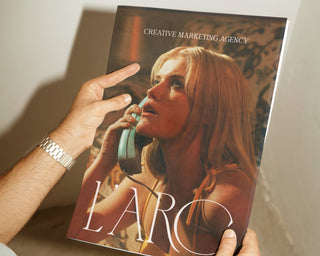Introduction: The Art of Branding, Served on a Silver Platter
Ever wondered why some brands feel like a five-star experience while others seem more like a drive-thru? The answer lies in brand perception, exclusivity, and meticulous attention to detail—all things that the world of Michelin-starred dining has mastered.
Branding, much like fine dining, is not just about offering a product or service; it’s about crafting an experience that delights, surprises, and lingers in memory. Whether you’re running an e-commerce brand, a SaaS company, or a personal brand, there’s a lot to learn from the world's most elite restaurants. So, let’s take a seat at the table and break down how the Michelin-star approach can elevate your branding.
1. Signature Aesthetic: Every Detail Matters
Lesson: Create a Cohesive and Memorable Brand Identity
Step into a Michelin-star restaurant, and you’ll notice that everything—from the lighting and table setting to the plating of the food—feels intentional. The restaurant’s theme is reflected in every tiny element. Nothing is accidental.
The same principle applies to branding. Your visuals, typography, color scheme, and packaging should all tell the same story. A brand that appears inconsistent—using a different tone on social media than on its website or changing logos too often—feels chaotic, untrustworthy, and forgettable.
Example: Apple’s sleek, minimalist branding across products, stores, and packaging creates an instantly recognizable aesthetic, just like how a dish from Noma is unmistakably “Noma.”
Key Takeaway:
Craft a signature brand aesthetic that is meticulously consistent across all platforms, from social media to product packaging.
2. Exclusivity & Scarcity: The Power of Being Hard to Get
Lesson: Make Your Brand Desirable Through Limited Access
Michelin-starred restaurants don’t seat just anyone. Reservations are booked months in advance, and some have secret menus or exclusive dining experiences that only a select few can access.
Scarcity breeds desire. People value what is not easily available. Brands can leverage this by creating:
-
Limited-edition products
-
VIP memberships or gated content
-
Exclusive experiences
Example: Brands like Supreme use drop culture—releasing limited inventory that sells out within minutes—to create hype and demand.
Key Takeaway:
Build demand by introducing exclusivity, waitlists, and limited releases into your branding strategy.
3. Flawless Customer Experience: Anticipate Needs Before They’re Expressed
Lesson: Elevate Your Customer Experience to Luxury Status
A Michelin-star restaurant offers seamless service—waiters refill your glass before you realize it’s empty, and dishes arrive in perfect succession. They don’t just serve food; they curate an experience.
Brands that go the extra mile in anticipating customer needs win lifelong loyalty. This could mean:
-
Hyper-personalized recommendations (think Spotify or Netflix’s algorithms)
-
Proactive customer support (chatbots, real-time assistance, hassle-free returns)
-
Exquisite unboxing experiences (Apple’s packaging makes opening a product an event in itself)
Example: Zappos, known for its customer service, famously once upgraded a late-night order to overnight delivery at no charge.
Key Takeaway:
Go beyond transactions—anticipate customer needs, personalize experiences, and create delight at every touchpoint.
4. A Story That Sticks: Emotional Storytelling Wins Every Time
Lesson: Make People Feel Something
Every Michelin-starred restaurant has a story—it could be about the chef’s journey, the locally sourced ingredients, or the cultural inspiration behind the menu. These narratives turn a simple meal into a deeply engaging experience.
Your brand needs to do the same. People connect with stories, not products. A compelling brand story should:
-
Explain why your brand exists beyond profit
-
Evoke emotions (excitement, nostalgia, aspiration)
-
Align with customer values and aspirations
Example: Airbnb’s brand is not just about booking stays; it’s about belonging anywhere in the world. Their marketing taps into real human experiences, not just room listings.
Key Takeaway:
Use authentic storytelling to craft a brand narrative that resonates emotionally with your audience.
5. Mastering the Art of Presentation: First Impressions Matter
Lesson: Prioritize High-Quality Branding Materials
Michelin-star restaurants don’t just serve food—they present art. Every dish is plated to perfection, creating a visual and sensory experience before the first bite.
Your branding should have the same impact. Your:
-
Website should be sleek, functional, and engaging
-
Social media content should look premium and well-designed
-
Product packaging should feel luxurious and thoughtful
Example: Tiffany & Co.’s iconic blue box is just as much a part of the luxury experience as the jewelry inside.
Key Takeaway:
Ensure every touchpoint with your brand is visually appealing and thoughtfully designed to enhance customer perception.
6. Consistency: Reputation is Earned Over Time
Lesson: Build Brand Trust Through Consistency
Earning a Michelin star takes years of consistent excellence. A single bad review, an underwhelming dish, or a slip in service can cost a restaurant its hard-earned reputation.
Similarly, brands must maintain consistent quality, messaging, and service. Switching up your brand identity too often, neglecting existing customers, or making frequent major pivots can damage trust and credibility.
Example: Nike has maintained its “Just Do It” messaging and quality-driven branding for decades, reinforcing its status as a leader in sportswear.
Key Takeaway:
Your brand’s reputation is built over time with consistency—don’t chase trends, focus on long-term brand loyalty.
Conclusion: Serve Up a Five-Star Brand Experience
Building a Michelin-starred brand doesn’t require a restaurant—but it does require a dedication to excellence, experience, and storytelling. The best brands don’t just sell products; they create an entire world their customers want to be part of.
To recap, here’s how you can bring a Michelin-star approach to your branding:
-
Perfect your brand aesthetic—be intentional with visuals and design.
-
Leverage exclusivity—make your brand feel desirable and special.
-
Obsess over customer experience—anticipate needs and go beyond expectations.
-
Tell a compelling story—people connect with narratives, not just products.
-
Prioritize presentation—first impressions count, make yours unforgettable.
-
Be consistent—build reputation through long-term brand coherence.
Ready to take your brand from good to unforgettable? Let’s make it Michelin-star worthy. 🚀



